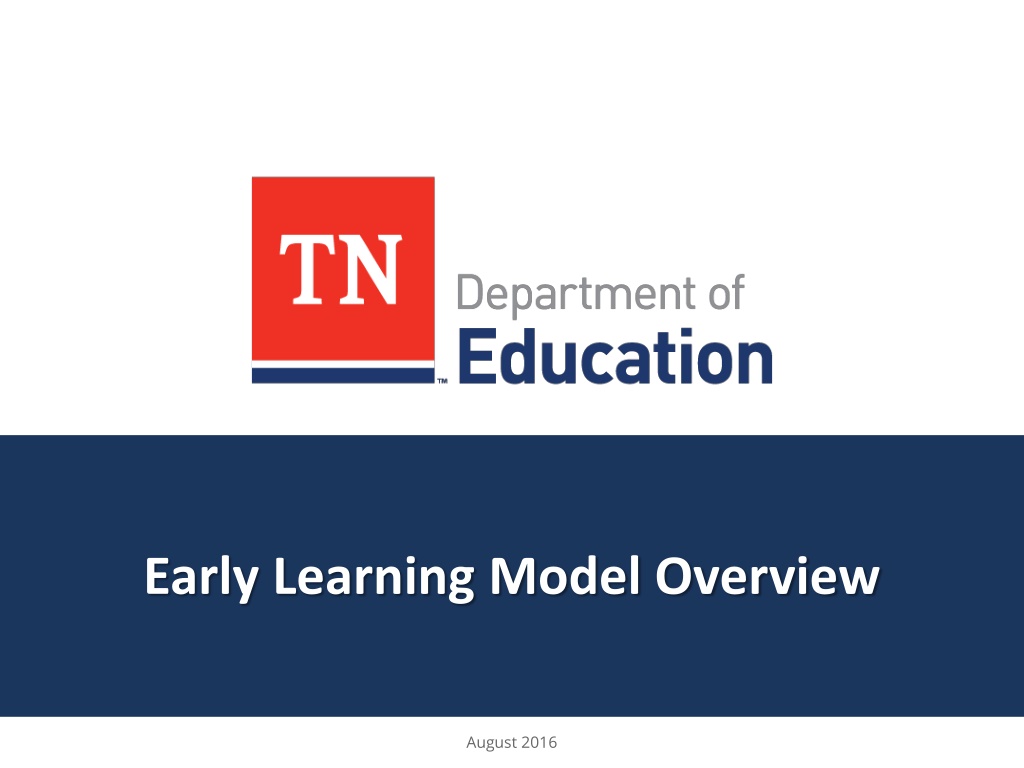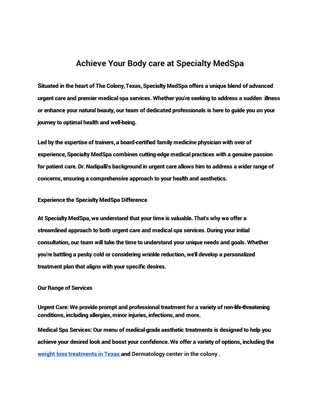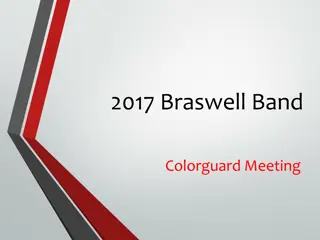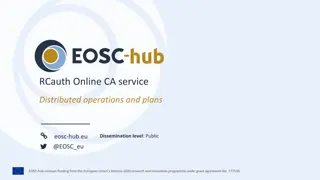Comprehensive Overview of Tennessee's Early Learning Model
The Early Learning Model (ELM) in Tennessee aims to enhance teaching and learning in pre-K and kindergarten, ensuring academic, social, and emotional growth for students. Through initiatives like the Kindergarten Entry Inventory and pre-K student growth portfolio model, the state endeavors to establish a continuous learning pathway from pre-K to third grade. Participants in meetings will gain insights on implementing ELM, connecting with state initiatives, and identifying success indicators for district, school, teacher, and student levels.
Download Presentation

Please find below an Image/Link to download the presentation.
The content on the website is provided AS IS for your information and personal use only. It may not be sold, licensed, or shared on other websites without obtaining consent from the author. Download presentation by click this link. If you encounter any issues during the download, it is possible that the publisher has removed the file from their server.
E N D
Presentation Transcript
Early Learning Model Overview August 2016
Agenda The Early Learning Model Tennessee Succeeds The state of pre-K in Tennessee Pre-K/K student growth portfolio model Kindergarten Entry Inventory Early Learning Model in 2016-17
Outcome By the end of today s meeting participants will be equipped to: describe the connections between other state initiatives and the Early Learning Model share talking points in home districts about the critical parts of the Early Learning Model name what Early Learning Model success looks like for district leaders, school leaders, teachers, and students
Early Learning Model The Early Learning Model (ELM) is a comprehensive plan to improve teaching and learning in pre-k and kindergarten. pre-K student growth portfolio model Kindergarten Entry Inventory (KEI) The goal of ELM is to ensure all students grow and thrive academically, socially and emotionally during the pre-K and kindergarten years so that we create a continuum of learning that will ensure students success from pre-K through third grade. kindergarten student growth portfolio model improve VPK quality
Early Learning Model [Video 1]
Vision Districts and schools in Tennessee will exemplify excellence and equity such that all students are equipped with the knowledge and skills to successfully embark upon their chosen path in life.
Goals 2 1 3 Tennessee will continue rapid improvement and rank in the top half of states on the Report Card. The average ACT score in Tennessee will be a 21, allowing more students to earn HOPE scholarships. The majority of Tennessee high school graduates will earn a certificate, diploma, or degree. MEASUREMENT Tennessee will rank in top half of states on 4th and 8th grade NAEP in 2019. MEASUREMENT Tennessee will have an average public ACT composite score of 21 by 2020. MEASUREMENT The class of 2020 will be on track to achieve 55% postsecondary completion in six years.
Early Foundations and Literacy Building skills in early grades to contribute to future success Increase department support and monitoring of programs that serve birth to age five students to ensure a solid foundation for learning Rolling out Kindergarten Entry Inventory with a small set of pilot districts this fall and statewide in 2017 Creating a new second grade assessmentto monitor students progress in early grades Increasing the number of educators enrolled in or completing state reading courses to 3,200 educators Sharing vision for elementary reading proficiency developed by Early Literacy Council Partnering with over 80 districts on the Read to be Ready coaching initiative Awarded 20 Read to be Ready Summer Grants; each region received at least one grant to fund summer instructional programs
Educator Support Supporting the preparation and development of an exceptional educator workforce Provided additional flexibility for teacher evaluation composite Expanding portfolio assessment options to more districts and more subject areas, including pre-K and kindergarten teachers Testing incentive programs that differentiate salaries, including the Tennessee Teacher Leader Network,throughout the state Pairing teachers in an increasing number of schools through the Instructional Partnership Initiative to provide data-based opportunities for personalized professional learning Launched the Governor s Academy for School Leadership for 24 assistant principals and the Transformational Leadership Councilto guide the state s direction across multiple leadership initiatives
Early Foundations and Literacy Initiatives Read to Be Ready Initiative Read to Be Ready Coaching Network Reading courses Response to Intervention Early Learning Model Entry Inventory Kindergarten Second Grade VPK quality Third Grade standards program Portfolios Portfolios Assessment Assessment Portfolios Pre-K 3 K 2 1 Professional Learning
Reflection With your team or neighbor, briefly describe how Tennessee Succeeds connects to the Early Learning Model. If questions develop, jot them on the post-it notes found on your tables and we will revisit the questions later.
The State of Pre-K in Tennessee
Tennessee Voluntary Pre-K (TN-VPK) Tennessee Voluntary Pre-K Program 1998-2017 20,000 18,000 16,000 14,000 Students Enrolled 12,000 10,000 8,000 6,000 4,000 2,000 0
TN-VPK Evaluation In 2009, the USDOE funded a joint proposal from Vanderbilt s Peabody Research Institute and the department to study the effects of TN-VPK. What are the effects of the current TN-VPK program on the academic and social-emotional skills of participating at-risk children? Do their experiences in later grades sustain, or even add to, the gains children made in TN-VPK? What enhancements have the greatest potential for improving the effectiveness of TN-VPK?
Key Findings from the TN-VPK Study Pre-K had a positive impact for the children who attended the program. Pre-K gains are not sustained over time and eventually reversed. Wide variability in quality of classrooms, how time is spent in classrooms, and outcomes for children.
What We Know from Other TN-VPK Data To ensure success for students, districts need: Shared vision for what defines VPK quality Shared definition of kindergarten readiness Professional learning for pre-K teachers Professional learning for elementary principals
TN-VPK Strategic Priorities Define quality Develop shared definition of kindergarten readiness Strengthen pre-K programs and instruction Support district efforts to provide meaningful, job- embedded professional development to pre-K teachers Provide meaningful professional development for pre- K supervisors and elementary principals
TN-VPK Quality Program Standards
TN-VPK Quality Program Standards 1. 2. 3. 4. 5. 6. Serve high needs students as defined by TN-VPK eligibility requirements Focus on access for families and attendance for students Use data-driven approach to improve student outcomes Ensure curriculum is high quality and aligned to TN-ELDS Ensure daily schedule reflects developmentally appropriate practice Provide nurturing and responsive care for every student in every classroom Support pre-K teachers through effective professional development and evaluation practices Observe and monitor classrooms to ensure continuous improvement Engage and support families 10. Engage community to develop successful partnerships 7. 8. 9.
Pre-K/K Student Growth Portfolio Model
What is a student growth portfolio model? Purposeful collection of student work organized into evidence collections that demonstrate student growth within the state standards Uses a scoring guide that includes the levels of performance for various standards Contains student work from two points in time Contains student work at varying levels (emerging, proficient, advanced)
The Power of Portfolios Through the use of portfolios, students can develop and understand criteria for good work, apply these criteria to their own work efforts and that of other students, increase critical thinking and self-reflection, examine how they succeeded or failed or improved on a task, and set goals for future work. No longer is the learning just about the final product, evaluation or grade but becomes more focused on students developing metacognitive skills that will enable them to reflect upon and make adjustments in their learning in school and beyond. https://dese.mo.gov/sites
The Power of Student Work [Video 2]
The Power of Portfolios No longer is the learning just about the final product, evaluation or grade but becomes more focused on students developing metacognitive skills that will enable them to reflect upon and make adjustments in their learning in school and beyond.
Why student growth portfolio model? P Teacher Developed Professional Learning and Growth Student Centered Student Growth Portfolio Model Peer Reviewed Flexible Assessment
Student Growth Portfolio Models Existing district-specific assessments tools, such as universal screeners and curriculum-based formative assessments, can be used as additional evidence to support the teacher s diagnosis of the student s level at Point A and the student s level at Point B. However, these district-specific tools DO NOT replace the authentic, standards-based student work that drives the portfolio. Student Work Point A Student Work Point B
How does looking at student work improve teacher practice? [Video 3]
Student Work at the Center Drives teacher generated assessment (formative) Drives differentiation/small group instruction Builds reflection in teachers AND students Fosters collaboration in PLCs/collaborative teacher groups Connects to students making their own goals, and assessing their growth along the way Fosters student talk about student work Increases effective teacher planning Deepens content knowledge about deconstructing standards Shows authentic strength and areas of need in individual students
Point A and Point B Samples Possible evidence: Videotaped segments that demonstrate student actions or talk Photographs of student work Audio of student talk
Reflection With your team or neighbor, develop talking points that you can share with your district about what is most important to know about the portfolio. If additional questions develop, jot them down on a post- it note. If any previous questions have been answered, please mark them as answered.
Where do portfolios fit within evaluation? Portfolios generate an individual growth measure (individual TVAAS score) Ach Measure 15% Part of the quantitative component of evaluation Qualitative 50% Growth Measure 35%
Portfolio Scores and Overall Scores Portfolio and Average Observation Score Alignment (n=1563) 50% 43.4% 45% 40% 34.7% 35% Percent of Teachers 30% 25% 20% 16.1% 15% 10% 5.8% 5% 0% Same Score Within 1 Point Within 2 Points 3 or More Points Score Differences
Portfolio vs. Non-Portfolio Difference in Overall Observation Score for Portfolio Growth Model Participants Compared to Non-Participants Thinking 0.11 Activities and Materials 0.09 Problem Solving 0.08 Average Observation 0.04 Average Instructional Domain 0.04 0.00 0.01 0.02 0.03 0.04 0.05 0.06 0.07 0.08 0.09 0.10 0.11 0.12 0.13 0.14 0.15 Observation Rating (1-5) Findings statistically significant (p < .01)
Kindergarten Entry Inventory
Kindergarten Entry Inventory (KEI) Purpose Inform kindergarten instruction Assess quality of children s preschool experiences
What is provided by a KEI? The Kindergarten Entry Inventory provides a comprehensive developmental profile for every child, focused on five essential developmental domains. Language & Literacy Approaches to learning Mathematics Social- emotional development Physical development
How does the KEI work? The KEI is administered by kindergarten teachers during the first eight weeks of school. The assessment is conducted during the course of regular schools days and schedules. The KEI is comprised of 50 items in three different formats: 1. Selected response items student selects the correct response from three choices provided 2. Performance tasks student engages in an activity with the teacher, often using manipulatives 3. Observations teachers observe students working and interacting in the normal course of a day The KEI is designed to take no more than 45 minutes per student, if administered at one time. The teacher has control over when the KEI is administered based on her/his schedule and planning.
How does the KEI look in practice? [Video 4]


![❤[READ]❤ Deep Space Craft: An Overview of Interplanetary Flight (Springer Praxis](/thumb/21511/read-deep-space-craft-an-overview-of-interplanetary-flight-springer-praxis.jpg)




















